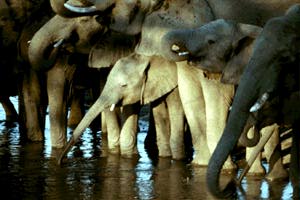
Created in 1929, this is Zimbabwe's largest National Park (over 5 000 sq miles) and holds some of the densest wildlife concentrations in Africa. Located in north-western Matabeleland, it is bordered by communal lands on the east and south, Botswana on the west and Safari Areas on the north.
The park headquarters is at Main Camp, close to an airport served by the national airline. Two other camps, Sinamatella and Robins, are located near the park's northern boundary. History In the 19th century parts of Hwange formed the Ndebele kings' hunting reserve. The region was later denuded of much of its wildlife by white hunters and settlers, and by the time the park was created it had fairly low wildlife populations.
It was created not primarily for ecological reasons but because with its poor soils and scarce water suplies the area was largely useless for agriculture. Its first warden, Ted Davison, walked over most of the park's immense area, assessed its wildlife populations, instituted protection against poaching and began to develop it for tourism.
He estimated the elephant population to be under 1 000 and the black and the white rhinoceros had been eliminated. Over 60 artificial pans were created in the dry heart of the park, enabling wildlife populations to make use of areas hitherto inaccessible in the dry months. There was a massive increase in available fodder and in wildlife populations.
By the mid-1970s, Hwange held over 20 000 elephant, the densest concentration in Africa. Such increases brought fresh problems in terms of habitat over-use and destruction. Today, the elephant population is being reduced to about 12 000 by culling (see wildlife management).
When this reduction has been achieved, elephants and habitats should reach a state of equilibrium and further destruction will be halted. The park also supports 15 000 buffalo, 3 000 zebra, 3 000 giraffe, 5 000 kudu, 2 000 sable antelope, 6 000 impala and large numbers of other animals, including roan antelope, gemsbok, wildebeeste, tsessebe and hartebeest.
Black and white rhinoceros have been reintroduced successfully; hippopotamus and crocodile have become resident in some permanent pans and small dams; and over 400 bird species occur in the park. Predators such as lion and leopard are plentiful throughout the park. Spotted hyaena are common, and cheetah and the rare brown hyaena occur in some areas.
There are several packs of wild dog, an endangered species. Vegetation Hwange's central and southern regions form the north-eastern tip of the Kalahari desert, with deep sands supporting mopane scrub and sparse grass cover. The park may once have been a desert and in the south-east are the remains of gigantic 'fossil dunes'.
This arid period was followed by a wetter interlude during which several rivers flowed south-west towards inland lakes and swamps in Botswana. The remnants of these 'fossil rivers' can be seen at the Kennedy pans and Linkwasha vlei east of Main Camp. In the north-east the scrub is replaced by some of Zimbabwe's finest forests of teak, Baikiaea plurijuga.
In the north-west mature mopane woodlands have developed in the more broken country characteristic of the region. Management and tourism Several factors have combined to make the park one of the most intensively managed and developed of all the Zimbabwean wildlife areas.
Its proximity to the Victoria Falls makes it a natural centre for overseas tourism. There is an international-class hotel just outside the park and an intricate network of viewing roads and tracks provides access to many of the pans. However, although development has been relatively intense around the main park centres, most of the park's area is still inaccessible to the casual visitor and its wilderness qualities have been retained.
Park management policy today is to maintain the natural ecosystems and habitat types, and to redevelop past populations of certain species, such as rhinoceros and wild dog, while reducing numbers of over-abundant species, such as elephant. Although such a policy may seem highly artificial at first sight, it is aimed mainly at redressing the mistakes of the past.